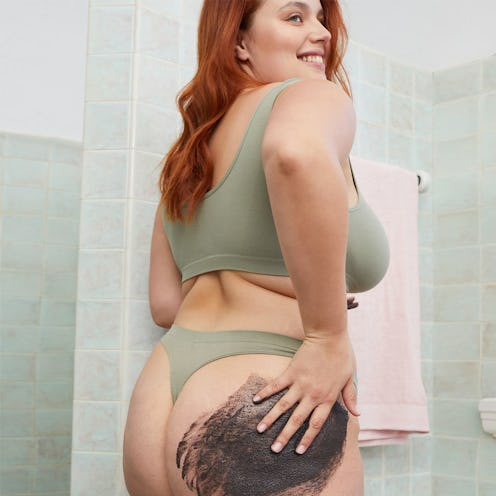Beauty
How To Target Body Breakouts
Experts offers tips for tackling backne & bumne.

Body acne: it's sort of considered the more mysterious, rarely talked about younger sister to facial breakouts, with many of us shying away from discussing it. Breakouts on our bums and backs still seem to carry taboo, but there's zero shame in talking about them, and they're just as common as spots on your face! I spoke to two experts about how to target body breakouts, who are here to offer their top tips and advice for all types of bacne and bumne. As well as their unparalleled recommendations, there's also a small selection of products that will help to clear up any body acne you're not happy about.
Bacne
What is bacne?
Similar to regular acne, bacne occurs "when pores on your back get clogged with oil and dead skin cells," explains Tessa Budry, the head of global media at Frank Body. She adds:
"There are two types of bacne: non-inflammatory and inflammatory. In the non-inflammatory corner, we have whiteheads (closed clogged pores) and blackheads (open clogged pores). In the inflammatory corner, we have papules (raised pimples), pustules (pimples with pus), cysts (ruptured clogged pores), and nodules (tissue growth)."
What causes bacne?
There are certain causes you may have already guessed. Burdy confirms that "sweat, fragranced laundry detergent, tight clothes, and heaters" are all possible triggers.
However, Jennifer Rock, dermal facialist and founder of Skingredients, adds that certain causes are less obvious. "You may be experiencing bacne due to hormonal changes such as your period or a change in birth control, for example, or due to higher stress levels," she says.
How can you prevent bacne?
Both experts agree that the first step is to ensure you take off your workout clothes as soon as possible after exercising. Then, of course, you should shower to wash away any excess sweat and oil. You should also be sure to wash your workout gear as much as possible too so bacteria doesn't build up.
Rock explains that if this along with wearing loose-fitting clothing and loosening straps does not work, it's crucial to try to figure out what else could be causing it. "A skincare professional or medical professional may be the way forward to assist with any underlying causes," she suggests.
How should you treat bacne?
Budry suggests investing in two products to target the problem: an anti-acne body wash (think charcoal or salicylic acid) as well as a body scrub. "Exfoliation involves removing the top layer of dead skin cells that would otherwise block your pores and cause bacne," she says.
And now "the advice nobody loves to hear," as Rock calls it: "Don’t pop the spots and don’t allow your partner, housemate, sister or friend pop them either, unless they are washing their hands beforehand and using a downward to outward motion with the pads of their fingers, not their nails!" Sob.
"Treating spots on your back and avoiding popping them will help to reduce the appearance of scarring," she finishes.
Bumne
What is bumne?
First off, it's important to understand that bacne and bumne are inherently different. "Bumne is those pesky bum spots that so many of us experience – however, it’s not like bacne in that it is not usually caused by excess sebum," says Rock. "If you have tried to pop a bum spot, you’ll know that they are unpoppable, and this is because they’re not really spots but more a form of irritation."
What causes bumne?
While many of the same things that cause bacne can be behind Bumne (no pun intended), Rock explains that bumne "is usually caused by chafing and irritation" by things like tight underwear, shaving, and using heavy moisturisers on the area.
A recent article from Glamour points out that bumne can also be caused by something else: too much sitting. Dr Tiina Meder, dermatologist, cardiologist, and founder of Meder Beauty Science told the magazine: "Constant contact with surfaces through clothes, the warmth sitting creates and the inevitable trouble of blood and lymphatic circulation are aggravating factors for existing buttne and present a risk factor for new breakouts."
Since sitting down is pretty much all we've been doing for 2020 (thanks, COVID), bumne may be even more of an issue this year.
How can you prevent bumne?
In general, much of the same stuff applies to preventing bumne as it does bacne. In other words, "by keeping pores clean and regularly exfoliating," says Budry, adding: "Also avoid sweaty tight clothing and ensure your skin is able to breathe in natural fabrics."
Rock says that you can also use this as an excuse to invest in some new underwear. "Two words: breathable undies," she says. "Go for 100% cotton if you can."
"If you believe your bumne could be from shaving, follow a good shaving hygiene," she adds. "Keep the blades dry between uses, change the blades frequently, and shave in the direction of hair growth rather than against it!"
How should you treat bumne?
One word: exfoliation. Plus Rock recommends investing in a lightweight hydrating spritz for your bum. "Ingredients like hyaluronic acid will help to deeply hydrate the skin without creating a thick occlusive layer!"
We only include products that have been independently selected by Bustle UK's editorial team. However, we may receive a portion of sales if you purchase a product through a link in this article.
This article was originally published on